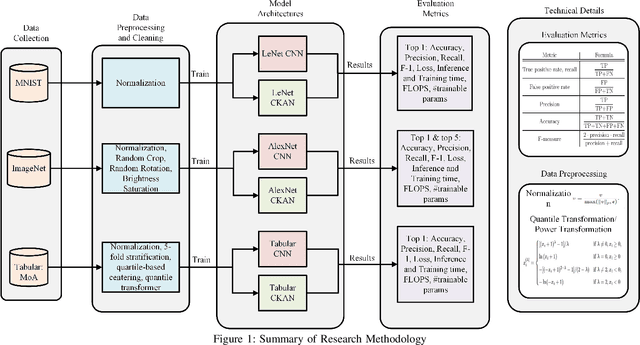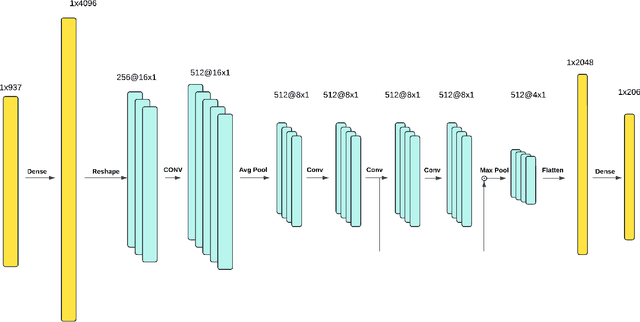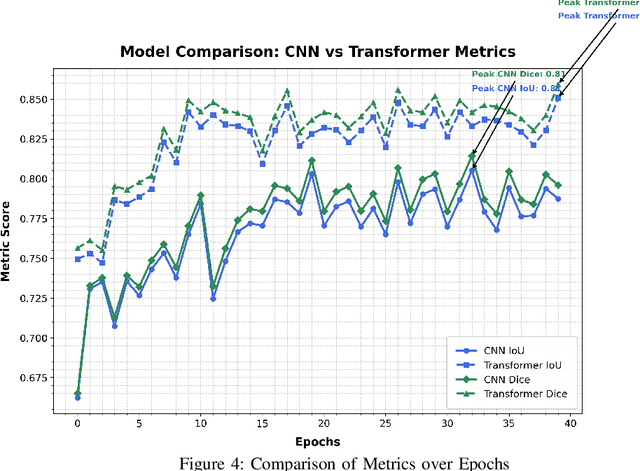Saydul Akbar Murad
Neural Network-based Study for Rice Leaf Disease Recognition and Classification: A Comparative Analysis Between Feature-based Model and Direct Imaging Model
Jul 03, 2025Abstract:Rice leaf diseases significantly reduce productivity and cause economic losses, highlighting the need for early detection to enable effective management and improve yields. This study proposes Artificial Neural Network (ANN)-based image-processing techniques for timely classification and recognition of rice diseases. Despite the prevailing approach of directly inputting images of rice leaves into ANNs, there is a noticeable absence of thorough comparative analysis between the Feature Analysis Detection Model (FADM) and Direct Image-Centric Detection Model (DICDM), specifically when it comes to evaluating the effectiveness of Feature Extraction Algorithms (FEAs). Hence, this research presents initial experiments on the Feature Analysis Detection Model, utilizing various image Feature Extraction Algorithms, Dimensionality Reduction Algorithms (DRAs), Feature Selection Algorithms (FSAs), and Extreme Learning Machine (ELM). The experiments are carried out on datasets encompassing bacterial leaf blight, brown spot, leaf blast, leaf scald, Sheath blight rot, and healthy leaf, utilizing 10-fold Cross-Validation method. A Direct Image-Centric Detection Model is established without the utilization of any FEA, and the evaluation of classification performance relies on different metrics. Ultimately, an exhaustive contrast is performed between the achievements of the Feature Analysis Detection Model and Direct Image-Centric Detection Model in classifying rice leaf diseases. The results reveal that the highest performance is attained using the Feature Analysis Detection Model. The adoption of the proposed Feature Analysis Detection Model for detecting rice leaf diseases holds excellent potential for improving crop health, minimizing yield losses, and enhancing overall productivity and sustainability of rice farming.
Redemption Score: An Evaluation Framework to Rank Image Captions While Redeeming Image Semantics and Language Pragmatics
May 22, 2025Abstract:Evaluating image captions requires cohesive assessment of both visual semantics and language pragmatics, which is often not entirely captured by most metrics. We introduce Redemption Score, a novel hybrid framework that ranks image captions by triangulating three complementary signals: (1) Mutual Information Divergence (MID) for global image-text distributional alignment, (2) DINO-based perceptual similarity of cycle-generated images for visual grounding, and (3) BERTScore for contextual text similarity against human references. A calibrated fusion of these signals allows Redemption Score to offer a more holistic assessment. On the Flickr8k benchmark, Redemption Score achieves a Kendall-$\tau$ of 56.43, outperforming twelve prior methods and demonstrating superior correlation with human judgments without requiring task-specific training. Our framework provides a more robust and nuanced evaluation by effectively redeeming image semantics and linguistic interpretability indicated by strong transfer of knowledge in the Conceptual Captions and MS COCO datasets.
EEG-to-Text Translation: A Model for Deciphering Human Brain Activity
May 20, 2025Abstract:With the rapid advancement of large language models like Gemini, GPT, and others, bridging the gap between the human brain and language processing has become an important area of focus. To address this challenge, researchers have developed various models to decode EEG signals into text. However, these models still face significant performance limitations. To overcome these shortcomings, we propose a new model, R1 Translator, which aims to improve the performance of EEG-to-text decoding. The R1 Translator model combines a bidirectional LSTM encoder with a pretrained transformer-based decoder, utilizing EEG features to produce high-quality text outputs. The model processes EEG embeddings through the LSTM to capture sequential dependencies, which are then fed into the transformer decoder for effective text generation. The R1 Translator excels in ROUGE metrics, outperforming both T5 (previous research) and Brain Translator. Specifically, R1 achieves a ROUGE-1 score of 38.00% (P), which is up to 9% higher than T5 (34.89%) and 3% better than Brain (35.69%). It also leads in ROUGE-L, with a F1 score of 32.51%, outperforming T5 by 3% (29.67%) and Brain by 2% (30.38%). In terms of CER, R1 achieves a CER of 0.5795, which is 2% lower than T5 (0.5917) and 4% lower than Brain (0.6001). Additionally, R1 performs better in WER with a score of 0.7280, outperforming T5 by 4.3% (0.7610) and Brain by 3.6% (0.7553). Code is available at https://github.com/Mmurrad/EEG-To-text.
Embedding Shift Dissection on CLIP: Effects of Augmentations on VLM's Representation Learning
Mar 30, 2025Abstract:Understanding the representation shift on Vision Language Models like CLIP under different augmentations provides valuable insights on Mechanistic Interpretability. In this study, we show the shift on CLIP's embeddings on 9 common augmentation techniques: noise, blur, color jitter, scale and rotate, flip, elastic and perspective transforms, random brightness and contrast, and coarse dropout of pixel blocks. We scrutinize the embedding shifts under similarity on attention map, patch, edge, detail preservation, cosine similarity, L2 distance, pairwise distance and dendrogram clusters and provide qualitative analysis on sample images. Our findings suggest certain augmentations like noise, perspective transform and shift scaling have higher degree of drastic impact on embedding shift. This study provides a concrete foundation for future work on VLM's robustness for mechanical interpretation and adversarial data defense.
Efficiency Bottlenecks of Convolutional Kolmogorov-Arnold Networks: A Comprehensive Scrutiny with ImageNet, AlexNet, LeNet and Tabular Classification
Jan 27, 2025



Abstract:Algorithmic level developments like Convolutional Neural Networks, transformers, attention mechanism, Retrieval Augmented Generation and so on have changed Artificial Intelligence. Recent such development was observed by Kolmogorov-Arnold Networks that suggested to challenge the fundamental concept of a Neural Network, thus change Multilayer Perceptron, and Convolutional Neural Networks. They received a good reception in terms of scientific modeling, yet had some drawbacks in terms of efficiency. In this paper, we train Convolutional Kolmogorov Arnold Networks (CKANs) with the ImageNet-1k dataset with 1.3 million images, MNIST dataset with 60k images and a tabular biological science related MoA dataset and test the promise of CKANs in terms of FLOPS, Inference Time, number of trainable parameters and training time against the accuracy, precision, recall and f-1 score they produce against the standard industry practice on CNN models. We show that the CKANs perform fair yet slower than CNNs in small size dataset like MoA and MNIST but are not nearly comparable as the dataset gets larger and more complex like the ImageNet. The code implementation of this paper can be found on the link: \href{https://github.com/ashimdahal/Study-of-Convolutional-Kolmogorov-Arnold-networks}{https://github.com/ashimdahal/Study-of-Convolutional-Kolmogorov-Arnold-networks}
Heuristical Comparison of Vision Transformers Against Convolutional Neural Networks for Semantic Segmentation on Remote Sensing Imagery
Nov 14, 2024



Abstract:Vision Transformers (ViT) have recently brought a new wave of research in the field of computer vision. These models have done particularly well in the field of image classification and segmentation. Research on semantic and instance segmentation has emerged to accelerate with the inception of the new architecture, with over 80\% of the top 20 benchmarks for the iSAID dataset being either based on the ViT architecture or the attention mechanism behind its success. This paper focuses on the heuristic comparison of three key factors of using (or not using) ViT for semantic segmentation of remote sensing aerial images on the iSAID. The experimental results observed during the course of the research were under the scrutinization of the following objectives: 1. Use of weighted fused loss function for the maximum mean Intersection over Union (mIoU) score, Dice score, and minimization or conservation of entropy or class representation, 2. Comparison of transfer learning on Meta's MaskFormer, a ViT-based semantic segmentation model, against generic UNet Convolutional Neural Networks (CNNs) judged over mIoU, Dice scores, training efficiency, and inference time, and 3. What do we lose for what we gain? i.e., the comparison of the two models against current state-of-art segmentation models. We show the use of the novel combined weighted loss function significantly boosts the CNN model's performance capacities as compared to transfer learning the ViT. The code for this implementation can be found on \url{https://github.com/ashimdahal/ViT-vs-CNN-ImageSegmentation}.
MpoxSLDNet: A Novel CNN Model for Detecting Monkeypox Lesions and Performance Comparison with Pre-trained Models
May 31, 2024



Abstract:Monkeypox virus (MPXV) is a zoonotic virus that poses a significant threat to public health, particularly in remote parts of Central and West Africa. Early detection of monkeypox lesions is crucial for effective treatment. However, due to its similarity with other skin diseases, monkeypox lesion detection is a challenging task. To detect monkeypox, many researchers used various deep-learning models such as MobileNetv2, VGG16, ResNet50, InceptionV3, DenseNet121, EfficientNetB3, MobileNetV2, and Xception. However, these models often require high storage space due to their large size. This study aims to improve the existing challenges by introducing a CNN model named MpoxSLDNet (Monkeypox Skin Lesion Detector Network) to facilitate early detection and categorization of Monkeypox lesions and Non-Monkeypox lesions in digital images. Our model represents a significant advancement in the field of monkeypox lesion detection by offering superior performance metrics, including precision, recall, F1-score, accuracy, and AUC, compared to traditional pre-trained models such as VGG16, ResNet50, and DenseNet121. The key novelty of our approach lies in MpoxSLDNet's ability to achieve high detection accuracy while requiring significantly less storage space than existing models. By addressing the challenge of high storage requirements, MpoxSLDNet presents a practical solution for early detection and categorization of monkeypox lesions in resource-constrained healthcare settings. In this study, we have used "Monkeypox Skin Lesion Dataset" comprising 1428 skin images of monkeypox lesions and 1764 skin images of Non-Monkeypox lesions. Dataset's limitations could potentially impact the model's ability to generalize to unseen cases. However, the MpoxSLDNet model achieved a validation accuracy of 94.56%, compared to 86.25%, 84.38%, and 67.19% for VGG16, DenseNet121, and ResNet50, respectively.
Unveiling Thoughts: A Review of Advancements in EEG Brain Signal Decoding into Text
Apr 26, 2024Abstract:The conversion of brain activity into text using electroencephalography (EEG) has gained significant traction in recent years. Many researchers are working to develop new models to decode EEG signals into text form. Although this area has shown promising developments, it still faces numerous challenges that necessitate further improvement. It's important to outline this area's recent developments and future research directions. In this review article, we thoroughly summarize the progress in EEG-to-text conversion. Firstly, we talk about how EEG-to-text technology has grown and what problems we still face. Secondly, we discuss existing techniques used in this field. This includes methods for collecting EEG data, the steps to process these signals, and the development of systems capable of translating these signals into coherent text. We conclude with potential future research directions, emphasizing the need for enhanced accuracy, reduced system constraints, and the exploration of novel applications across varied sectors. By addressing these aspects, this review aims to contribute to developing more accessible and effective Brain-Computer Interface (BCI) technology for a broader user base.
Impact Learning: A Learning Method from Features Impact and Competition
Nov 04, 2022Abstract:Machine learning is the study of computer algorithms that can automatically improve based on data and experience. Machine learning algorithms build a model from sample data, called training data, to make predictions or judgments without being explicitly programmed to do so. A variety of wellknown machine learning algorithms have been developed for use in the field of computer science to analyze data. This paper introduced a new machine learning algorithm called impact learning. Impact learning is a supervised learning algorithm that can be consolidated in both classification and regression problems. It can furthermore manifest its superiority in analyzing competitive data. This algorithm is remarkable for learning from the competitive situation and the competition comes from the effects of autonomous features. It is prepared by the impacts of the highlights from the intrinsic rate of natural increase (RNI). We, moreover, manifest the prevalence of the impact learning over the conventional machine learning algorithm.
 Add to Chrome
Add to Chrome Add to Firefox
Add to Firefox Add to Edge
Add to Edge